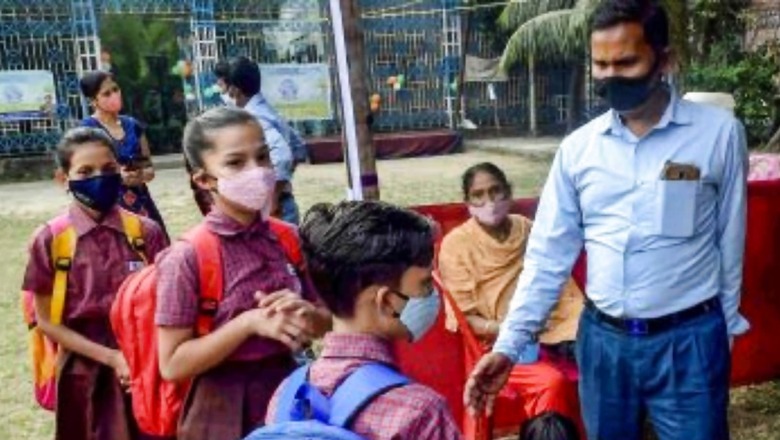
views
If recent COVID regulations are any indication, then schools must be one of the deadliest places for children to be in. Why else would they be shut when everything else is open — restaurants, theatres, bars, clubs, election rallies, the list goes on. Schools have finally reopened in about 11 states, while 16 states have reopened schools partially.
The decision to keep schools closed even as malls remained open was baffling not only because it did nothing to keep children safe as children mingled with everyone anyway on a daily basis, but also because of the abundant evidence that children (especially below 10) are the least vulnerable when it comes to developing severe disease as a result of COVID. This does not mean children are not susceptible to contracting COVID. It simply means the risk of severe diseases or death by covid is very low for children (especially below the age of 10). The other fear that schools are sites for super spreading has not borne out in experience either. When schools selectively opened in mid-2021 in states like Punjab, Maharashtra, and others, infections did not spike in the community.
Many countries like Australia, Japan, South Africa, the US, UK and China chose to have their schools largely open through 2021. Their experience is worth studying. According to the American Academy of Pediatrics, children have represented 0.00% to 0.27% of all COVID-19 deaths. That’s less than the number of total deaths from both influenza and RSV infection in a typical year before the pandemic. A recent study of children in Germany found that no healthy child between the ages of 5 and 17 died of COVID during a 15-month period when nearly all were unvaccinated. Zero. In the whole country.
People might argue that Indian conditions are different — we are a crowded country, and our public health system is in shambles. That is true. However, school closures could be justified on those grounds only if our children were sitting at home, 100% of the time, never interacting with anyone who is moving around outside. If Indian children are out and about in other crowded places — markets, melas, malls, birthday parties, with nannies (who move in crowded spaces in their own personal time), how is coming to school any different? Especially when not going to school comes with huge costs.
In the last two years, millions of children, especially the youngest, have not seen the inside of a classroom. A range of evidence in the field of education shows clear linkages between children missing school and adverse lifelong outcomes which includes lower earnings (as per World Bank, every year of schooling lost translates to potentially ~9 per cent lower future earnings for a student), and higher maternal mortality for girls who don’t complete secondary education. A recent study by the Centre for Global Development suggests that more than 6 per cent of all children in India are unlikely to return to school after the pandemic. 1.6 million girls aged 11 to 14 years in India are currently out of school, the pandemic could impact girls further by pushing them into household labour, early marriages, and even trafficking.
The situation for children from economically weak backgrounds is undoubtedly worse. A report by Azim Premji Foundation stated that on average, 92 per cent of children have lost at least one specific language ability from the previous year across all classes because no one has taught them anything properly in two years. What about remote online learning? The latest ASER survey report states that 26 per cent of children still do not have access to any device, and only 40 per cent of younger children have no access despite having devices at home. Even when children have access to online classes, a flat-screen experience, dominated by the mute button, is hardly the learning experience any child should have for longer than absolutely necessary.
Even those who are more fortunate have suffered enough. We are seeing two generations of children who have now lived a dystopian childhood for nearly 2 years (for a 6-year-old, 2 years is 33 per cent of the life lived by her).
Doctors have reported on poorer health outcomes for young children, and educators world over (and in India) are talking about the impact on young children who have spent a majority of their early childhood in lockdown. Educators have noticed 3 and 4‑year-olds finding it a real challenge to play together, to share, wait for their turn, and to manage their emotions. This should concern everyone, because “what happens early, can matter for a lifetime”.
We are also constantly hearing about the silent mental health epidemic in older children.
The trauma of being at home, coupled with the fear of abuse and of the disease, has had a traumatic impact on several children. In the first week of the lockdown in March 2020, there was a 50 per cent increase in the number of phone calls to the Childline India helpline.
Schools, unlike retail outlets like malls, bars and restaurants, are living communities that cannot be shut and be opened at will. First, the longer disruptions continue, the harder it is to revive basic amenities, re-engage children and motivate teachers. Talk to any teacher and principal and you will realise how fatigued they already are — teaching online classes, preventing dropouts, preserving fee revenue and dealing with uncertainty over their own future. Keeping schools closed has dealt a body blow to an already weakened education system.
Learning is a continuum where every lesson builds on the previous one. Imagine trying to teach fractions to a 4th-grade child, when she has forgotten about multiplication and division thanks to two years of missed school. And paradoxically, while higher grades have been prioritised, it is the early years that need in-person education more when it comes to both academic and socio-emotional learning.
It is hard to imagine the work cut out for the beleaguered cadre of teachers and educators when schools do properly and firmly open. If the socio-economic cost of closing schools is enormous and the public health risk of re-opening is minuscule — then we are left with just one morally defensible choice. Let schools be the first to open and the last to close in any eventuality.
Needless to say, opening schools will require careful planning and execution. Children must be eased back into school, first by providing socio-emotional support to undo the years of isolation. Curriculum and instruction must be restructured to assess learning levels, meet children where they are in their learning journey, and give adequate time to catch up on lost learning.
None of this can happen without every citizen of the country courageously supporting schools in their process of reopening. Policymakers must not disregard the will of a silent majority of parents who want schools to open because they fear the backlash from a vocal minority. The media should try to not sensationalise isolated cases that may scare school management and parents.
Years from now, the millions of school-age children of today will be growing up to be adult citizens, as we enter the twilight of our lives. Let these young people then remember our generation as courageous caregivers, and not as fearmongers who failed to stand up for their right to a good education.
Let’s keep our schools open to give back our children the future they deserve!
Natasha Joshi is an education specialist who has worked on public education with organisations like UNICEF, Niti Aayog and Tata Trusts. Anustup Nayak is the Project Director at Central Square Foundation. The views expressed in this article are those of the authors and do not represent the stand of this publication.
Read all the Latest Opinions here















Comments
0 comment